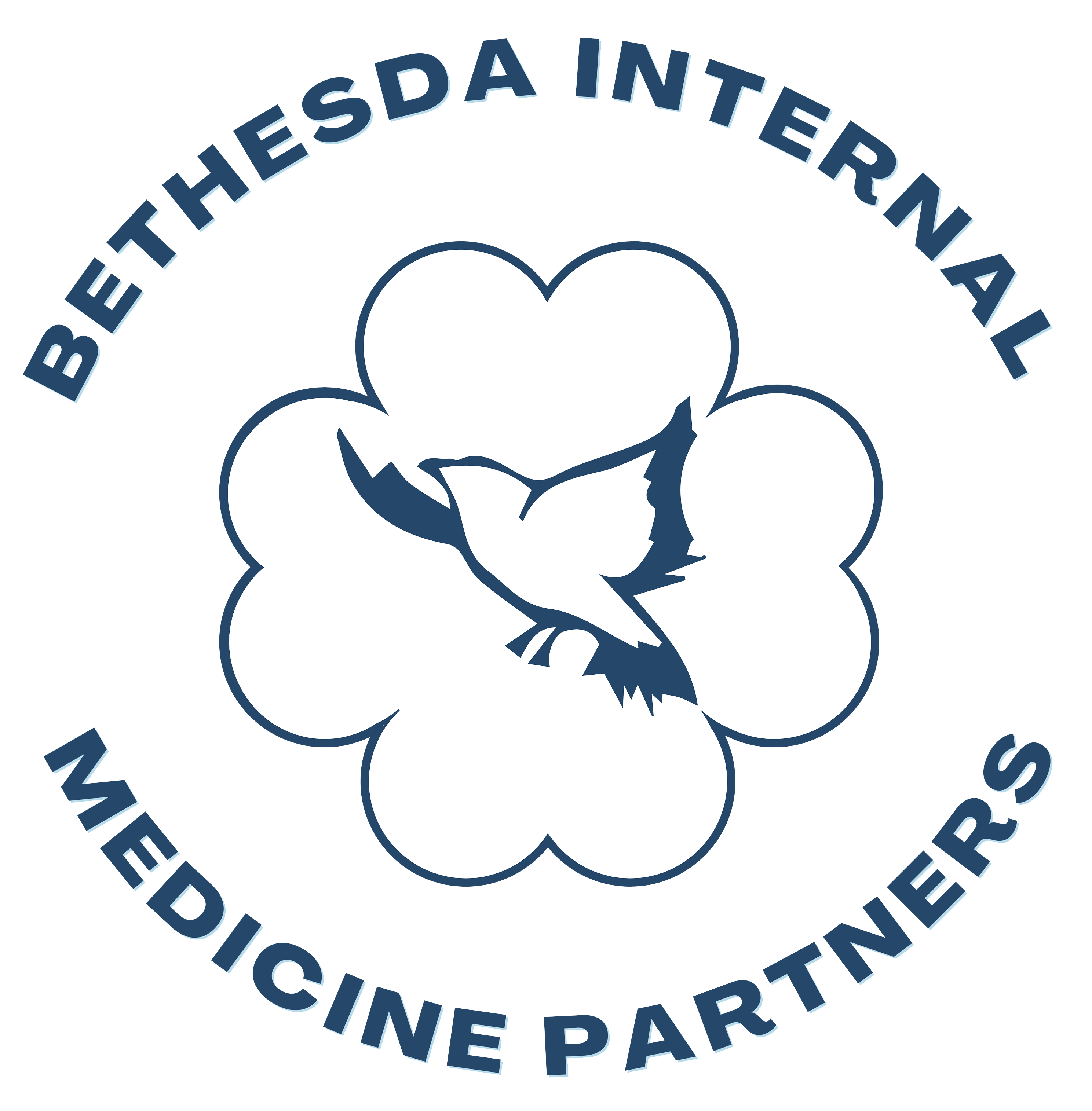MINERALS
Magnesium
- Assists more than 300 enzymes to carry out various chemical reactions.
- Acts as an electrical conductor that contracts muscles and makes the heartbeat steadily.
- Involved in building proteins and strong bones, and regulating blood sugar, blood pressure, and muscle and nerve functions.
- Required for energy production.
- Required for the synthesis of DNA, RNA and the antioxidant glutathione.
- Magnesium also plays a role in the active transport of calcium and potassium ions across cell membranes, a process that is important to nerve impulse conduction, muscle contraction, and normal heart rhythm.
- More than half of the magnesium in our body is stored in bones, and the remaining in various tissues throughout the body.
RDA for Magnesium
- Adults 19-51+ years is 400-420 mg daily for men and 310-320 mg for women.
- Pregnancy requires about 350-360 mg daily and lactation, 310-320 mg.
- The Upper Limit (UL) for magnesium is 350 milligrams from supplements only. High-dose supplements can lead to diarrhea, nausea, and cramping in some people. Extra magnesium from food is safe because the kidneys will eliminate excess amounts in urine.
- In 2022, the FDA approved a qualified health claim for conventional foods and dietary supplements that contain magnesium. One example of this claim states, “Consuming diets with adequate magnesium may reduce the risk of high blood pressure (hypertension). However, FDA has concluded that the evidence is inconsistent and inconclusive.”
- FDA also specifies that foods and dietary supplements carrying this claim on their labels must provide at least 84 mg of magnesium per serving and, for dietary supplements, no more than 350 mg.
Groups at Risk of Magnesium Inadequacy
- Symptomatic magnesium deficiency due to low dietary intake in otherwise-healthy people is uncommon because the kidneys limit urinary excretion of this mineral. However, habitually low intakes or excessive losses of magnesium due to certain health conditions, chronic alcoholism, and/or the use of certain medications can lead to magnesium deficiency.
- Early signs of magnesium deficiency include loss of appetite, nausea, vomiting, fatigue, and weakness. As magnesium deficiency worsens, numbness, tingling, muscle contractions and cramps, seizures, personality changes, abnormal heart rhythms, and coronary spasms can occur. Severe magnesium deficiency can result in hypocalcemia or hypokalemia (low serum calcium or potassium levels, respectively) because mineral homeostasis is disrupted.
- Magnesium inadequacy can occur when intakes fall below the RDA but are above the amount required to prevent overt deficiency. The following groups are more likely than others to be at risk of magnesium inadequacy because they typically consume insufficient amounts or they have medical conditions (or take medications) that reduce magnesium absorption from the gut or increase losses from the body.
People with gastrointestinal diseases
- The chronic diarrhea and fat malabsorption resulting from Crohn’s disease, gluten-sensitive enteropathy (celiac disease), and regional enteritis can lead to magnesium depletion over time.
- Resection or bypass of the small intestine, especially the ileum, typically leads to malabsorption and magnesium loss.
People with type 2 diabetes
- Magnesium deficits and increased urinary magnesium excretion can occur in people with insulin resistance and/or type 2 diabetes.
- The magnesium loss appears to be secondary to higher concentrations of glucose in the kidney that increase urine output.
People with alcohol dependence
- Magnesium deficiency is common in people with chronic alcoholism. In these individuals, poor dietary intake and nutritional status; gastrointestinal problems, including vomiting, diarrhea, and steatorrhea (fatty stools) resulting from pancreatitis; renal dysfunction with excess excretion of magnesium into the urine; phosphate depletion; vitamin D deficiency; acute alcoholic ketoacidosis; and hyperaldosteronism secondary to liver disease can all contribute to decreased magnesium status.
Older adults
- Older adults have lower dietary intakes of magnesium than younger adults. In addition, magnesium absorption from the gut decreases and renal magnesium excretion increases with age. Older adults are also more likely to have chronic diseases or take medications that alter magnesium status, which can increase their risk of magnesium depletion.
Food sources of magnesium
- Magnesium is found in plant foods like legumes, dark green leafy vegetables, nuts, seeds, whole grains, and fortified cereals. It is also in fish, poultry, and beef.
- Almonds, peanuts, cashews
- Pumpkin seeds
- Peanut butter
- Beans (black, kidney)
- Soybeans, soymilk
- Cooked spinach, Swiss chard
- White potato with skin
- Brown rice
- Oatmeal (instant, whole oats)
- Salmon, beef, poultry
- Banana, raisins
- Dark chocolate
- Milk, yogurt
Toxicity
- Toxicity is rare from food sources because the kidneys will remove excess magnesium in the urine. However toxic levels may occur with long-term use of high-dosage supplements. People with kidney disease have a higher risk of toxicity because their kidneys are not working properly and cannot flush out extra magnesium.
- Signs of toxicity include:
- Nausea, vomiting
- Diarrhea
- Low mood, depression
- Muscle weakness
- Low blood pressure, abnormal heartbeat
- Heart attack
|
- Salt, also known as sodium chloride, is about 40% sodium and 60% chloride. It flavors food and is used as a binder and stabilizer. It is also a food preservative, as bacteria can’t thrive in the presence of a high amount of salt.
- The human body requires a small amount of sodium to conduct nerve impulses, contract and relax muscles, and maintain the proper balance of water and minerals.
- It is estimated that we need about 500 mg of sodium daily for these vital functions.
Recommended amounts
- The U.S. Dietary Reference Intakes state that there is not enough evidence to establish a Recommended Dietary Allowance or a toxic level for sodium (aside from chronic disease risk). Because of this, a Tolerable Upper intake Level (UL) has not been established.
Adequate Intake
- For men and women 14 years of age and older and pregnant women, is 1,500 milligrams a day.
Sodium and Health
- In most people, the kidneys have trouble keeping up with excess sodium in the blood. As sodium accumulates, the body holds onto water to dilute the sodium. This increases both the amount of fluid surrounding cells and the volume of blood in the bloodstream.
- Increased blood volume means more work for the heart and more pressure on blood vessels. Over time, the extra work and pressure can stiffen blood vessels, leading to high blood pressure, heart attack, and stroke. It can also lead to heart failure.
- There is some evidence that too much salt can damage the heart, aorta, and kidneys without increasing blood pressure, and that it may be bad for bones too.
- The amount of calcium that your body loses via urination increases with the amount of salt you eat. If calcium is in short supply in the blood, it can leach out of bones. So, a diet high in sodium could have an additional unwanted effect—the bone-thinning disease known as osteoporosis.
- Research shows that a higher intake of salt, sodium, or salty foods is linked to an increase in stomach cancer. The World Cancer Research Fund and American Institute for Cancer Research concluded that salt, as well as salted and salty foods, are a “probable cause of stomach cancer.”
Food Sources
- Sodium isn’t generally a nutrient that you need to look for; it finds you. Almost any unprocessed food like fruits, vegetables, whole grains, nuts, meats, and dairy foods is low in sodium.
- Most of the salt in our diets comes from commercially prepared foods, not from salt added to cooking at home or even from salt added at the table before eating.
- According to The Centers for Disease Control and Prevention, the top 10 sources of sodium in our diets include: breads/rolls; pizza; sandwiches; cold cuts/cured meats; soups; burritos, tacos; savory snacks (chips, popcorn, pretzels, crackers); chicken; cheese; eggs, omelets.
- A deficiency of sodium in the U.S. is rare because it is so commonly added to a wide variety of foods and occurs naturally in some foods.
- Hyponatremiais the term used to describe abnormally low amounts of sodium in the blood. This occurs mainly in older adults, particularly those living in long-term care facilities or hospitals who take medications or have health conditions that deplete the body of sodium, leading to hyponatremia.
- Excess vomiting, diarrhea, and sweating can also cause hyponatremia if salt is lost in these fluids that are expelled from the body. Sometimes too much fluid abnormally collecting in the body can lead to hyponatremia, which might stem from diseases such as heart failure or liver cirrhosis.
- In rare cases, simply drinking too much fluid can lead to hyponatremia if the kidneys can’t excrete the excess water. Symptoms of hyponatremia can include nausea, vomiting, headaches, altered mental state/confusion, lethargy, seizures, and coma.
Toxicity
- Too much sodium in the diet can lead to high blood pressure, heart disease, and stroke. It can also cause calciumlosses, some of which may be pulled from bone.
- Most Americans consume at least 1.5 teaspoons of salt per day, or about 3400 mg of sodium, which contains far more than our bodies need.
- A Chronic Disease Risk Reduction (CDRR) Intake has also been established, based on the evidence of benefit of a reduced sodium intake on the risk of cardiovascular disease and high blood pressure. Reducing sodium intakes below the CDRR is expected to lower the risk of chronic disease in the general healthy population.
- The CDRR lists 2,300 milligrams a day as the maximum amount to consume for chronic disease reduction for men and women 14 years of age and older and pregnant women. Most people in the U.S. consume more sodium than the AI or CDRR guidelines.
- Too much sodium in the blood is called hypernatremia. This acute condition can happen in older adults who are mentally and physically impaired who do not eat or drink enough, or who are sick with a high fever, vomiting, or infection that causes severe dehydration.
- Excessive sweating or diuretic medications that deplete the body of water are other causes. When sodium accumulates in the blood, water is transferred out of cells and into the blood to dilute it.
- This fluid shift and a build-up of fluid in the brain can cause seizures, coma, or even death. Extra fluid collecting in the lungs can cause difficulty breathing. Other symptoms of hypernatremia can include nausea, vomiting, weakness, loss of appetite, intense thirst, confusion, kidney damage.
|
- Potassium is an essential mineral that is needed by all tissues in the body.
- Sometimes referred to as an electrolyte because it carries a small electrical charge that activates various cell and nerve functions.
- Its main role in the body is to help maintain normal levels of fluid inside our cells. It also helps muscles contract and supports normal blood pressure.
- The kidneys need magnesium to reabsorb potassium and maintain normal levels in the cells
Adequate Intake
- For women 14-18 years of age, the AI is 2,300 mg daily; for women 19+, 2,600 mg. For pregnant and lactating women, the AI ranges from 2,500-2,900 depending on age.
- For men 14-18 years of age, the AI is 3,000 mg for men 19+, 3,400 mg
Food sources
- Dried fruits (raisins, apricots) tomatoes
- Beans, lentils dairy/plant milks
- Potatoes cashews, almonds
- Winter squash (acorn, butternut) chicken
- Spinach, broccoli salmon
- Beet greens coconut water
- Avocado
- Bananas
- Cantaloupe
- Oranges, orange juice
Deficiency
The kidneys work to maintain normal blood levels of potassium by flushing out excess amounts through urine. Potassium can also be lost through stool and sweat. At least 400-800 mg daily from food is needed because of normal daily losses. Any conditions that increase fluid losses beyond normal such as vomiting, diarrhea, and certain medications like diuretics can lead to a deficiency, called hypokalemia. Hypokalemia is most common in hospitalized patients who are taking medications that cause the body to excrete too much potassium. It is also seen in people with inflammatory bowel diseases (Crohn’s disease, ulcerative colitis) that may cause diarrhea and malabsorption of nutrients.
It is rare for a potassium deficiency to be caused by too low a food intake alone because it is found in so many foods; however, an inadequate intake combined with heavy sweating, diuretic use, laxative abuse, or severe nausea and vomiting can quickly lead to hypokalemia. Another reason is a deficiency of magnesium, as the kidneys need magnesium to help reabsorb potassium and maintain normal levels in cells.
- Fatigue
- Muscle cramps or weakness
- Constipation
- Muscle paralysis and irregular heart rate (with severe hypokalemia)
Toxicity
Too much potassium in the blood is called hyperkalemia. In healthy people the kidneys will efficiently remove extra potassium, mainly through the urine. However, certain situations can lead to hyperkalemia: advanced kidney disease, taking medications that hold onto potassium in the body (including NSAIDs), or people who have compromised kidneys who eat a high-potassium diet (more than 4,700 mg daily) or use potassium-based salt substitutes. Symptoms of hyperkalemia:
- Weakness, fatigue
- Nausea, vomiting
- Shortness of breath
- Chest pain
- Heart palpitations, irregular heart rate
Phosphorus
Phosphorus is a mineral that naturally occurs in many foods
It plays multiple roles in the body. It is a key element of bones, teeth, and cell membranes.
It is used to activate enzymes and keeps blood pH within a normal range. Phosphorus regulates the normal function of nerves and muscles, including the heart, and is also a building block of our genes, as it makes up DNA, RNA, and ATP, the body’s major source of energy
RDA
adult men and women 19+ years is 700 mg
Upper Limit
adult men and women ages 19-70 years old is 4,000 mg daily
- Food sources
- Dairy: milk, yogurt, cheese
- Salmon
- Beef
- Poultry
- Pork
- Legumes
- Nuts, seeds
- Whole wheat breads and cereals
- Some vegetables: asparagus, tomatoes, cauliflower
- Processed foods (as inorganic phosphorus), especially deli meats, bacon, sausage, sodas, sports drinks, and other bottled beverages
A toxicity from phosphorus, called hyperphosphatemia, is rare because the body will regulate any excess levels in healthy individuals
Deficiency rare and usually only with kidney disease
Phosphorus is the second most abundant mineral in the body, second to calcium. About 85% of the body’s phosphorus is stored in bones and teeth.
Calcium
- Calcium is a mineral most often associated with healthy bones and teeth, although it also plays an important role in blood clotting, helping muscles to contract, and regulating normal heart rhythms and nerve functions
- The body gets the calcium it needs in two ways. One is by eating foods or supplements that contain calcium, and the other is by drawing from calcium in the body. If one does not eat enough calcium-containing foods, the body will remove calcium from bones
- About 99% of the body’s calcium is stored in bones, and the remaining 1% is found in blood, muscle, and other tissues
- the body works to keep a steady amount of calcium in the blood and tissues. If calcium levels drop too low in the blood, parathyroid hormone (PTH) will signal the bones to release calcium into the bloodstream. This hormone may also activate vitamin D to improve the absorption of calcium in the intestines. At the same time, PTH signals the kidneys to release less calcium in the urine. When the body has enough calcium, a different hormone called calcitonin works to do the opposite: it lowers calcium levels in the blood by stopping the release of calcium from bones and signaling the kidneys to rid more of it in the urine.
- Food sources:
- Dairy (cow, goat, sheep) and fortified plant-based milks (almond, soy, rice)
- Cheese
- Yogurt
- Calcium-fortified orange juice
- Winter squash
- Edamame (young green soybeans); Tofu, made with calcium sulfate
- Canned sardines, salmon (with bones)
- Almonds
- Leafy greens (collard, mustard, turnip, kale, bok choy)
RDA
- women 19-50 years of age is 1,000 mg daily: for women 51+, 1,200 mg.
- men 19-70 years of age, the RDA is 1,000 mg: for men 71+ years, 1,200 mg
Upper Limit
- Upper Limit for calcium, that is, 2,000-2,500 mg daily from food and supplements
Deficiency
- Blood levels of calcium are tightly regulated. Bones will release calcium into the blood if the diet does not provide enough, and no symptoms usually occur. A more serious deficiency of calcium, called hypocalcemia, results from diseases such as kidney failure, surgeries of the digestive tract like gastric bypass,
- Some research has shown that in certain people, calcium can accumulate in blood vessels with long-term high doses and cause heart problems.
Iron
- Iron is an important mineral that helps maintain healthy blood.
- Iron is a major component of hemoglobin, a type of protein in red blood cells that carries oxygen from your lungs to all parts of the body. Without enough iron, there aren’t enough red blood cells to transport oxygen, which leads to fatigue
- Iron is also part of myoglobin, a protein that carries and stores oxygen specifically in muscle tissues.
Iron is important for healthy brain development and growth in children, and for the normal production and function of various cells and hormones
- Food sources
- Oysters, clams, mussels
- Beef or chicken liver
- Organ meats
- Canned sardines
- Beef
- Poultry
- Canned light tuna
- Fortified breakfast cereals
- Beans
- Dark chocolate (at least 45%)
- Lentils
- Spinach
- Potato with skin
- Nuts, seeds
- Enriched rice or bread
- Iron from food comes in two forms: heme and non-heme. Heme is found only in animal flesh like meat, poultry, and seafood. Non-heme iron is found in plant foods like whole grains, nuts, seeds, legumes, and leafy greens.
- Iron is stored in the body as ferritin (in the liver, spleen, muscle tissue, and bone marrow) and is delivered throughout the body by transferrin (a protein in blood that binds to iron)
Deficiency
- An iron deficiency is seen most in children, women who are menstruating or pregnant, and those eating a diet lacking in iron.
- Toxicity is rare because the body regulates iron absorption and will absorb less if iron stores are adequate. Excessive iron occurs most often from taking high-dosage supplements when not needed or from having a genetic condition that stores too much iron.
Zinc
- Zinc is a trace mineral, meaning that the body only needs small amounts, and yet it is necessary for almost 100 enzymes to carry out vital chemical reactions.
- It is a major player in the creation of DNA, growth of cells, building proteins, healing damaged tissue, and supporting a healthy immune system.
- Zinc is also involved with the senses of taste and smell
- Food sources
- Shellfish: oysters, crab, lobster
- Beef
- Poultry
- Pork
- Legumes
- Nuts, seeds
- Whole grains
- Fortified breakfast cereals
RDA
- adults 19+ years is 11 mg a day for men and 8 mg for women
Upper Limit
- 40 mg daily for all males and females ages 19+ years
Adequate zinc is needed to create new cells, particularly collagen and fiber-like tissues, a necessary function in repairing damaged cells. Zinc also supports immune cell activity that combats inflammation from a wound.
Deficiency
A zinc deficiency is rare and is seen most in people who do not absorb zinc well due to digestive disorders such as inflammatory bowel diseases or who have undergone gastrointestinal surgery
Toxicity
Toxicity occurs almost exclusively from zinc supplements rather than food. There have been no reports of eating too much zinc from the diet alone. Signs of toxicity include Nausea, vomiting
Poor appetite
- Abdominal pain or cramping
- Headaches
- Diarrhea
- Excess zinc can interfere with the absorption of iron and copper
Selenium
- Selenium is an essential component of various enzymes and proteins, called selenoproteins, that help to make DNA and protect against cell damage and infections; these proteins are also involved in reproduction and the metabolism of thyroid hormones.
Most selenium in the body is stored in muscle tissue, although the thyroid gland holds the highest concentration of selenium due to various selenoproteins that assist with thyroid function
Selenium is a component of selenoproteins and enzymes. These have antioxidant properties that help to break down peroxides, which can damage tissues and DNA, leading to inflammation and other health problems.
Randomized controlled trials studying selenium supplementation show mixed results. Supplements have not been shown to significantly affect thyroid function in people with normal thyroid or mild hypothyroidism, despite causing increased blood levels of selenium. Other studies have shown selenium to decrease the amount of these antibodies and promote the activity of selenoproteins, which work to decrease inflammation.
RDA
- adult men and women 19+ years of age is 55 micrograms daily
Upper Limit
- adults 19+ years of age and pregnant and lactating women is 400 micrograms daily
Food sources
- Brazil nuts 544 mcg
- Fin fish and shellfish 47 mcg
- Beef 33 mcg
- Turkey 31 mcg
- Chicken 22 mcg
- Fortified cereals 60 mcg
- Whole-wheat bread 13 mcg
- Beans, lentils 13 mcg
Deficiency
- A deficiency of selenium in the U.S. is rare as the soil throughout North America is generally rich in selenium
- Chronically high intakes of selenium can lead to health problems, ranging from muscle tremors, hair loss, stomach upset, and lightheadedness, to more severe outcomes of heart attack, respiratory distress, or kidney failure. Brazil nuts are exceptionally high in selenium even when grown in low-selenium soil, with even one nut containing more than the RDA. Eating too many of these nuts daily can reach a toxic level, as well as using supplements that contain selenium in excess of the RDA.
Iodine
- Iodine is needed to make the thyroid hormones thyroxine and triiodothyronine, which assist with the creation of proteins and enzyme activity, as well as regulating normal metabolism.
- Without enough iodine, these thyroid hormones do not work properly and can lead to an under-active or overactive thyroid gland
- An early sign of hypothyroidism is having an elevated blood level of of thyroid stimulating hormone (TSH). This may occur with low intakes of iodine. It may also occur in people with a history of iodine deficiency who take high doses of iodine such as in supplements. [1] Goiter, a lump in the front of the neck from an enlarged inflamed thyroid gland, can result from hypothyroidism, hyperthyroidism, or an excessive iodine intake (usually involves taking very high doses of more than 18,000 mcg a day for a prolonged time).
- Production of thyroid hormones increases during pregnancy, requiring higher intakes of iodine. Both the fetus and infant require enough iodine for normal physical growth and brain development. Breast milk contains iodine, though the amount will depend on the mother’s diet, and many infant formulas contain iodine. However, not all prenatal multivitamins contain iodine. The American Academy of Pediatrics recommends that prenatal and lactating women take supplemental iodine by using iodized salt. [2] High-dose iodine supplements are not always advised, as they can cause thyroid problems in some women.
- Moderate to severe iodine deficiency in children can cause a lower IQ and stunted growth. Iodine supplementation in these children appears to improve both their physical and mental development.
RDA
- 150 micrograms (mcg) daily for adult men and women 19+ years
Upper Limit
adults 19+ years and pregnant and lactating women is 1,100 mcg daily
Food sources
- Seaweed (nori, kelp, kombu, wakame)
- Fish, shellfish (cod, canned tuna, oysters, shrimp)
- Table salts labeled “iodized”
- Dairy (milk, cheese, yogurt)
- Eggs
- Beef liver
- Chicken
- Fortified infant formula
Deficiency
Iodine regulates metabolism, the conversion of energy obtained from food into energy to help cells function and grow. A deficiency of iodine can therefore prevent normal growth and development
In adults, an iodine deficiency of less than 10-20 mcg a day can lead to inadequate thyroid hormone production, called hypothyroidism, which disrupts normal metabolic functions like regulating heart rate, body temperature, and body weight
High iodine intakes are usually well-tolerated in most healthy people and do not cause problems. This has been observed in countries such as Japan and Korea that eat iodine-rich seaweed regularly. But some people with autoimmune thyroid disease or who have a history of chronic iodine deficiency can be sensitive to receiving extra iodine, inducing conditions of iodine deficiency like hypothyroidism and goiter. Excess iodine can also lead to too much thyroid hormone production, causing hyperthyroidism; signs of this condition are an increased metabolism that promotes weight loss, fast or irregular heartbeat, hand tremors, irritability, fatigue, and sweatiness. Sometimes even just a slight increase in dietary iodine above the RDA can cause iodine-induced hyperthyroidism in sensitive individuals
Copper
- It is a cofactor for several enzymes (known as “cuproenzymes”) involved in energy production, iron metabolism, neuropeptide activation, connective tissue synthesis, and neurotransmitter synthesis
- Copper is also involved in many physiologic processes, regulation of gene expression, brain development, pigmentation, and immune system functioning
RDA
- Male and female 19+ 900 mcg
Upper Limit: adults 19+ 10000 mcg
Deficiency
Uncommon in humans but those at risk for deficiency include celiac disease, Menke’s disease, high doses of zinc
High dietary intakes of zinc can interfere with copper absorption, and excessive use of zinc supplements can lead to copper deficiency
Food sources
- Eastern oysters 3 oz 4850 mcg
- Baking chocolate 1 oz 938mcg
- 1 medium potato 675 mcg
- Dark chocolate > 70% 501 mcg
- Crab 3 oz 624 mcg
- Avocado ½ cup 219 mcg
- Asparagus ½ cup 149 mcg
Choline
- The body can also produce small amounts on its own in the liver, but not enough to meet daily needs.
- Choline is converted into a neurotransmitter called acetylcholine, which helps muscles to contract, activates pain responses, and plays a role in brain functions of memory and thinking
- Most choline is metabolized in the liver where it is converted into phosphatidylcholine, which assists in building fat-carrying proteins and breaking down cholesterol. It is also “food” for beneficial gut bacteria
RDA: none established, instead there is an adequate intake (AI)
Adequate Intake
- men and women ages 19+ years is 550 mg and 425 mg daily, respectively.
Upper Limit: 3500 mg daily
Deficiency
Phosphatidylcholine carries fats away from the liver, so a choline deficiency can cause the liver to store too much fat. This increases the risk for nonalcoholic fatty liver disease (NAFLD), Although a choline deficiency can lead to liver dysfunction, it is not yet clear if dietary choline or choline supplementation can treat NAFLD
Choline is associated with brain health because it is converted into acetylcholine, which plays a role in memory and thinking. Studies have found that people with Alzheimer’s disease have lower levels of an enzyme that converts choline into acetylcholine, and therefore theorize that higher dietary intakes of choline may prevent cognitive decline. Although some observational studies have found that higher intakes of choline are associated with higher levels of cognitive function like memory, clinical trials have not found that choline supplementation significantly improves these cognitive measures
Most Americans eat less than the AI for choline, but a deficiency is very rare in healthy persons, as the body can make some choline on its own
Also, the amount of dietary choline an individual needs can vary widely and depends on various factors. For example, premenopausal women may have lower requirements for dietary choline because higher estrogen levels stimulate the creation of choline in the body.
A true choline deficiency can lead to muscle or liver damage, and nonalcoholic fatty liver disease.
Toxicity
Very high intakes of choline can lead to low blood pressure (hypotension) and liver toxicity
Food sources
- Beef, beef liver 356 mg
- Egg yolks 147 mg
- Chicken breast 72 mg
- Fish 25 mg
- Shiitake mushrooms 27 mg
- Potatoes 57 mg
- Legumes (beans, peanuts) 45 mg
- Milk 43 mg
- Yogurt 38 mg
- Cruciferous vegetables (broccoli, cauliflower, Brussels sprouts, cabbage) 31 mg
- Sunflower seeds 19 mg
Chromium
- Chromium enhances the action of the hormone insulin
- It is also involved in the breakdown and absorption of carbohydrate, proteins, and fats.
RDA: none
Adequate Intake: men ages 19-50 years is 35 micrograms daily
- women ages 19-50 years, 25 micrograms daily
- Men and women older than 50 years require slightly less, at 30 and 20 micrograms daily, respectively.
Upper Limit: none
Chromium has been identified as a key player in the action of insulin and regulating blood glucose. Animal and human studies have shown that chromium supplementation corrects glucose intolerance in those who are deficient in the mineral
Lower chromium blood levels have been reported in patients with diabetes compared with control patients without diabetes. Some clinical trials have shown a benefit with chromium supplements in improving insulin sensitivity and glucose metabolism in participants with diabetes.
Because of these findings, chromium supplements are popular among people with diabetes. However, the exact mechanism of chromium in relation to insulin is not clearly understood.
Chromium supplements can interfere with many medications, among them corticosteroids, proton pump inhibitors, beta-blockers, insulin, and nonsteroidal anti-inflammatory drugs
Food sources
- Whole grains 3.6 mcg
- High-fiber bran cereals 3 mcg
- Certain vegetables: broccoli, green beans, potatoes 1 mcg
- Certain fruits: apples, bananas 1.4 mcg
- Beef 2 mcg
- Poultry, egg yolks 0.5 mcg
- Fish 0.6 mcg
- Brewer’s yeast 3.3 mcg
Deficiency
- A chromium deficiency is rare, even though the mineral is poorly absorbed, with only about 5% or less absorbed in the gut. Diets high in refined sugars can cause more chromium to be excreted in the urine.
Toxicity
- Harmful side effects linked to high intakes of chromium from food or supplements exist but are rare. This may be because chromium is poorly absorbed in the gut. Therefore, a Tolerable Upper Intake Level has not been established by the Institute of Medicine







